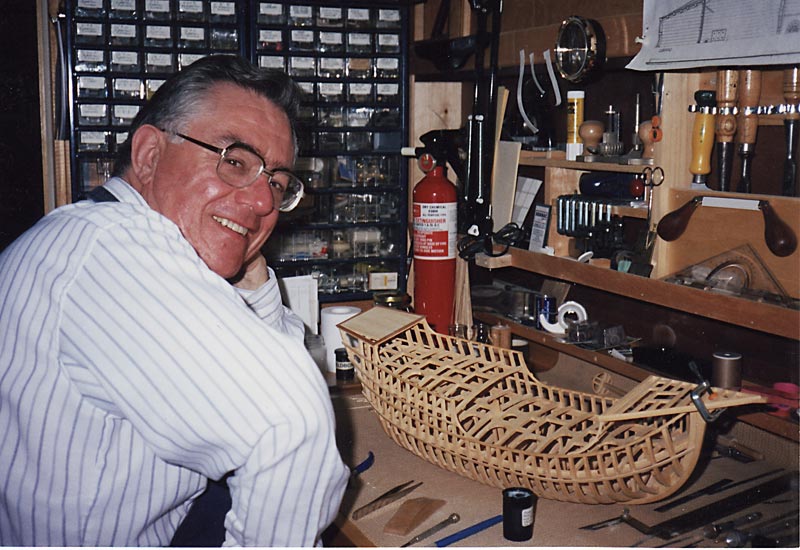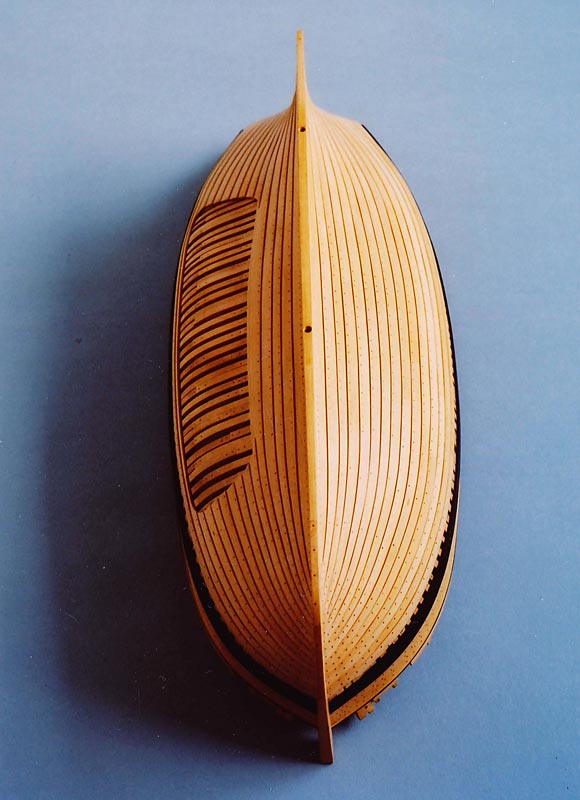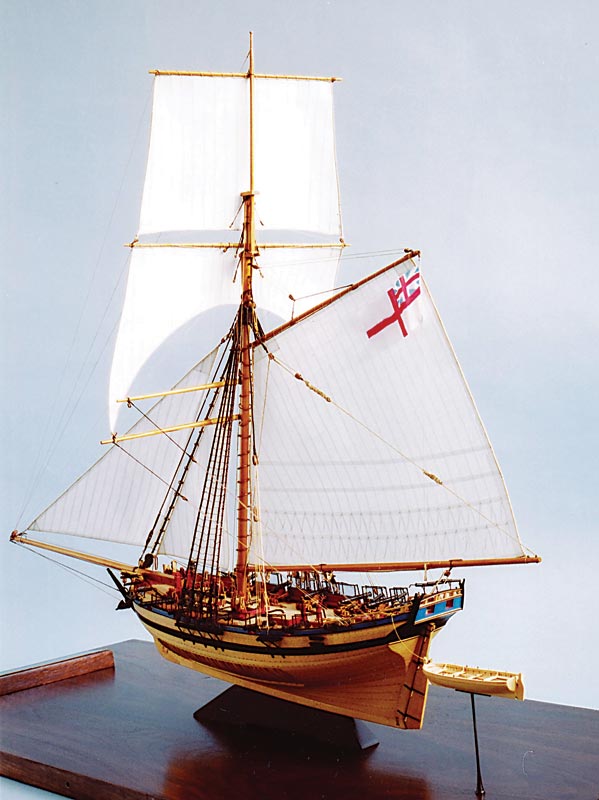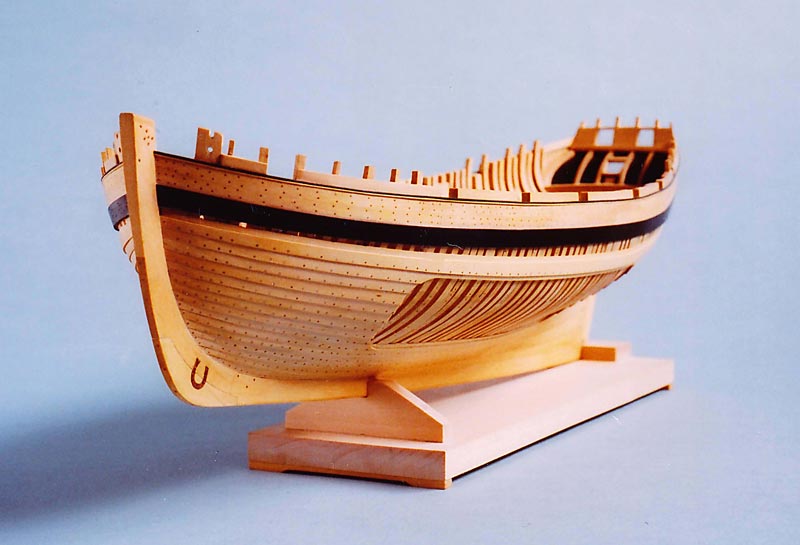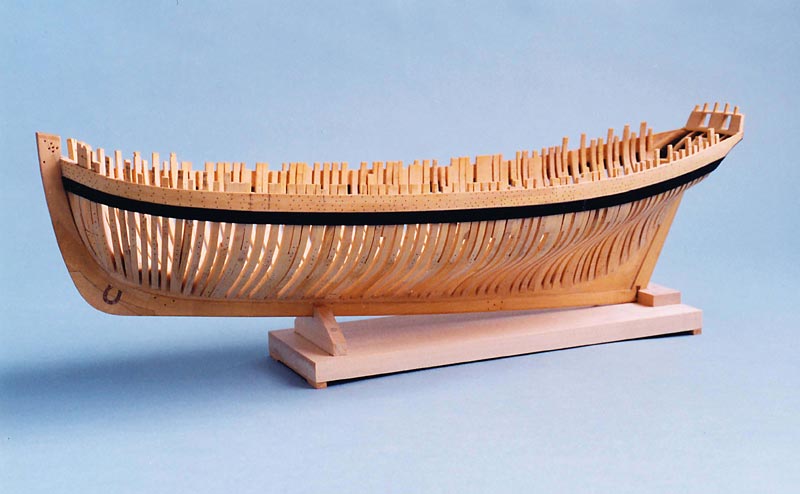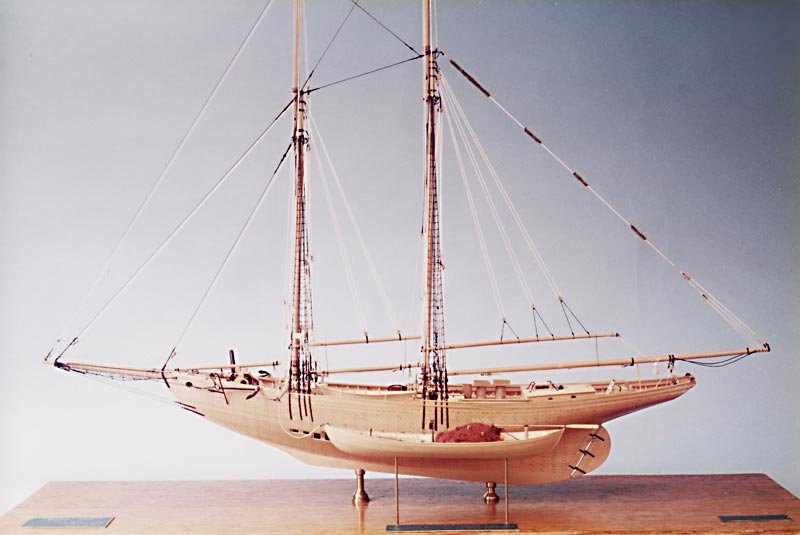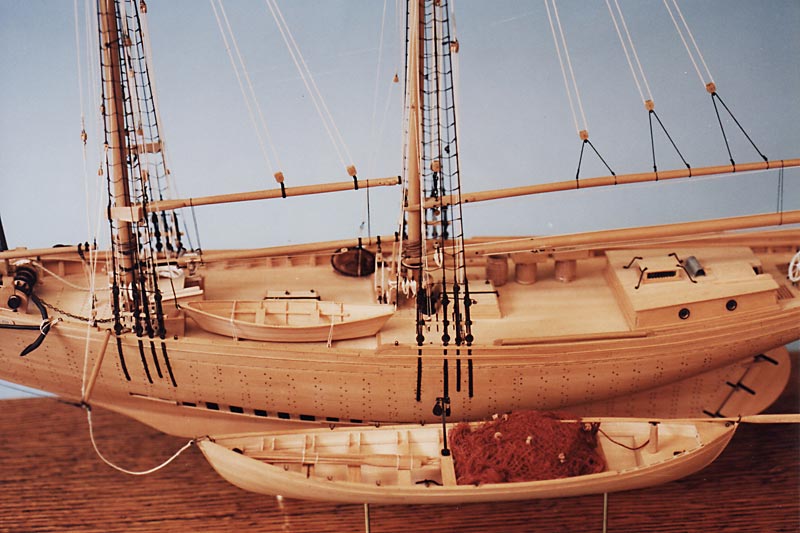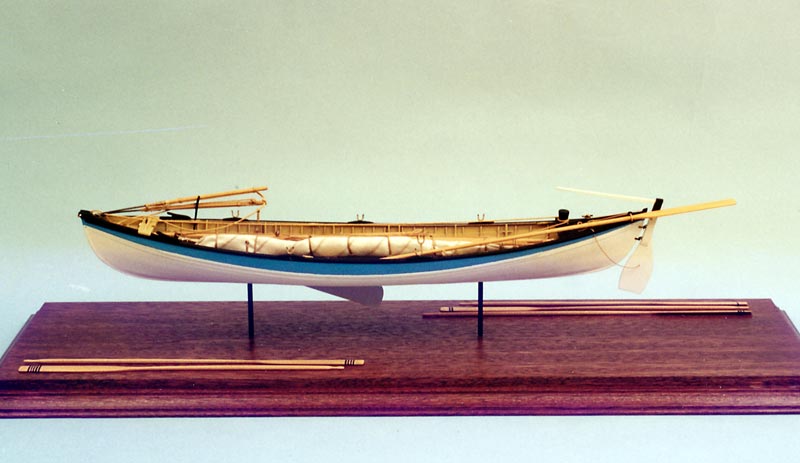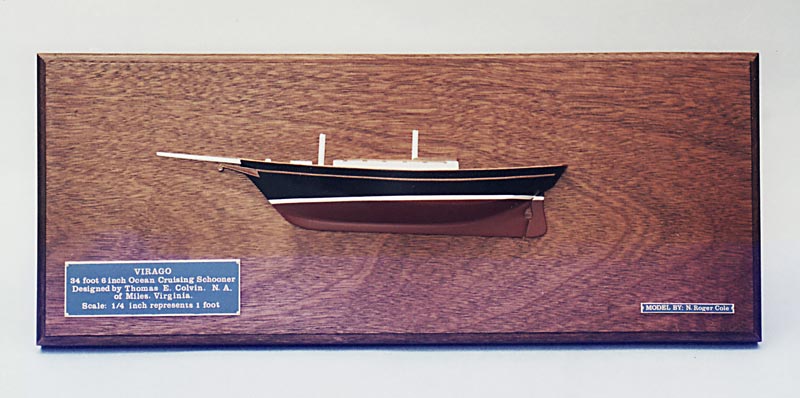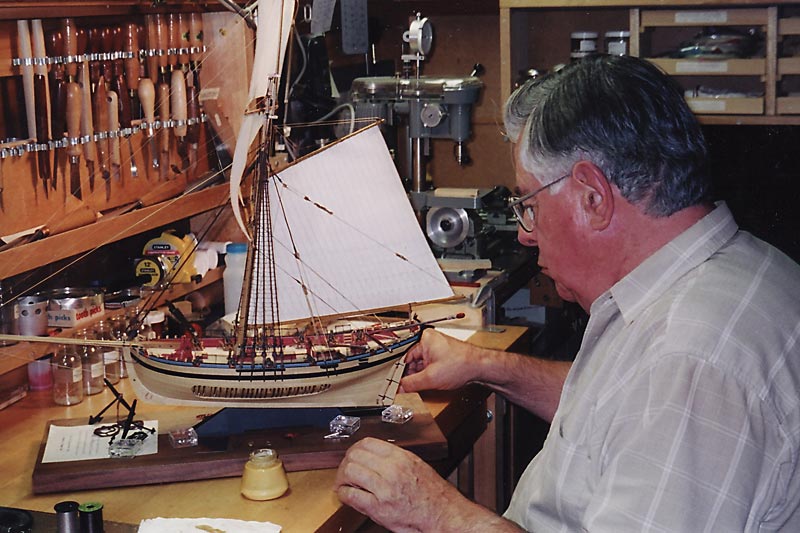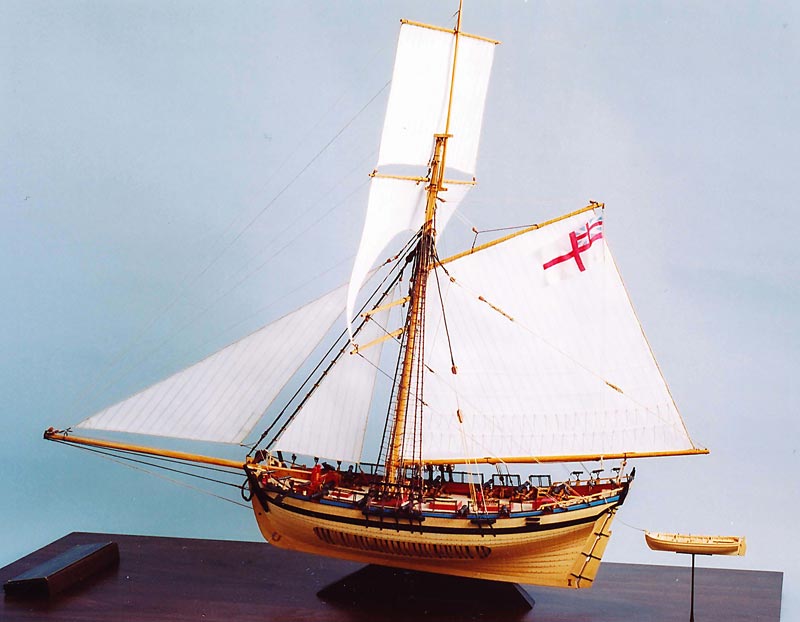1936–2019
Highly Detailed and Extensively Researched Wooden Ship Models
Introduction
The Joe Martin Foundation first caught wind of Roger Cole during a conversation with the 1999 Craftsman of the Year, Willhelm Huxhold. Mr. Huxhold, of Canada, was best known for his beautiful steam engine models. However, he was also a very accomplished ship modeler. When Willhelm was asked who he thought was the best ship modeler he’d met, his first recommendation was Roger Cole. After taking a look at his work, it was a unanimous decision to feature Roger here.
Roger’s models are excellent, but much of that may also owe to the fact that he was also an outstanding historian and writer. Roger wrote many articles on the ships that he researched and built in miniature. The Joe Martin Foundation values the sharing of information on the part of any craftsman, and we consider it an extra level of achievement—beyond making the projects themselves. Roger was a popular speaker at maritime conferences, symposiums, and meetings.
About N. Roger Cole
Mister Cole was born in Plymouth, Devon, England in 1936. Unfortunately, Roger’s father was killed shortly after his birth. Growing up in Plymouth, one is never far from the sea, ships, and boats. This is where Roger learned to appreciate all manner of vessels—from warships to fishing boats—with the latter interesting him most. As he grew older, he also took a serious interest in the ship models at the Plymouth Museum and Art Gallery. This museum had a collection of Napoleonic and War of 1812 Prisoner of War models, which was a life-long study of Roger’s. The museum also housed a variety of other models, including what are known as Navy Board models. These were framed boxwood models of major sailing warships.
While Roger was attending Davenport Technical College, which was just around the corner from the museum, the curator soon noticed his frequent lunch time visits. Seeing his interest in the models, and time permitting, the curator would often meet with Roger. The two would eat their brown bag lunches together while the curator explained the varied histories of the actual vessels. He would tell Roger about the techniques used to construct the models, although at that time Roger was more interested in sketching them.
At sixteen, Roger was apprenticed as a machinist in Plymouth. He specialized in all aspects of engine reconditioning machining, except for crankshaft grinding. He emigrated from England to Canada in 1955, with his tools and exactly thirteen dollars to his name—ten of which had to cover his first week of room and board. Fortunately, he was immediately hired in his field, and continued to work as an automotive machinist.
Later in 1958, Roger and his wife Jean were married. They moved into a bachelor apartment, and then into a one-bedroom. This gave Roger room to build kitchen-table models, starting with a Sterling kit of the Cutty Sark. However, he never completed the model because Jean accidently damaged it while attempting to dust the unfinished piece. After that, Roger tossed it to the garbage. It was the only kit model he ever tried. In 1960, Roger was hired by IBM. He started with field service in the electric typewriter division in downtown Toronto. Then in 1968, with a family that now included three youngsters, Roger and Jean moved into their longtime home.
In the new home, Roger finally had room for a dedicated workshop. It may have only been ten by six feet, but it was sufficient. That shop made due, but Roger would also go on to build another second shop at the house as well. His second shop was outside the house, and was seven by fourteen feet. The outside shop could also be heated, which is very important in Canada! For seventeen years Roger’s work at IBM, along with family commitments, kept him too busy for model building and the like.
Further down the road, in the mid-seventies, Roger decided to pursue ship modeling again. With a renewed passion, he started researching prospective models. In the process, Roger amassed a considerable library. That library has since been used frequently by other researchers looking for information. Roger himself never had a mentor, and is entirely self-taught. Looking back on his time spent with the curator at the Plymouth Museum, Roger decided to give up on kits, and to scratch build instead. He would use polished Boxwood to make the models.
Now, one vessel that particularly interested Roger was the Benjamin W. Latham—a mackerel seining schooner. The original ship was built in 1902, in Essex, Massachusetts. The Latham was available as a kit with plans, developed by Erik Ronnberg Jr.
This Latham model had a solid, machine-carved hull, and was produced through Model Shipways. Because Roger wanted to scratch build the model, frame the hull, and plank it in Columbian Boxwood, he simply ordered the plans and guide for modeling. Erik Ronnberg had arranged for Roger to research the framing on fishing schooners via the Francis Russell Hart Museum at M.I.T.
Once there, Roger spent four hours with then museum curator, the late William Avery Baker. Mr. Baker’s wife, Ruth, was also there helping Roger with everything. In that short span of time, Roger and Mr. Baker reviewed an enormous amount of material on the schooners. Following this research trip, framing plans were drawn and construction began!
When the hull was completed, Roger was invited to enter Latham as an unrigged model in a show. The event was called “Model Building Today,” and it was held in Mystic Seaport, Connecticut. Roger was invited to the event by Portia Takakjian, who was a director of the Nautical Research Guild at the time. After the show ended, Roger went on to complete the model. He had studied many other models at the Mystic Seaport show, and decided to enter the completed Latham into another competition.
Feeling good about his finished model, Roger entered the Latham into the Mariners’ Museum Ship Model Competition in Newport News, Virginia. It was 1980 at this time, and Roger’s Latham won the bronze medal in the Scratch Built division. To be sure, this was not a bad start to his modeling career—but it also came with some valuable help from a number of influential people. Roger noted that it may well have been their support that started him on a lifetime of mentoring himself.
Along with the Latham, Roger also entered a Chesapeake Bay Bugeye model into the Mariners’ Museum competition. It actually followed the Latham in garnering an honorable mention, despite the fact that it was a more complex model. Many of Roger’s projects developed into a series of informative articles. He wrote articles on the Santa Maria, Benjamin W. Latham, Lizzie J. Cox, and his Beetle Whaleboat. Roger also wrote many other articles covering specific techniques related to model building.
Shifting back to his career, Roger spent about 31 years in mostly management and staff positions. He ended up as the Emergency Response Coordinator for a 58 acre manufacturing and lab site. Eventually, Roger retired from IBM in 1991 to pursue a career in model building, writing, lecturing, teaching small classes from his home, and mentoring.
He found mentoring others to be the most rewarding experience, so he continued to do it very late into his life. Along with his experience building models, Roger was also a member of the Nautical Research Guild for over 42 years. Throughout this time, Roger never really thought of mentoring as giving back, although he certainly did just that.
As a member of the Guild’s Technical Assistance Network, Roger answered many questions on behalf of the organization. However, his role there was far outweighed by the sheer number of individual requests that Roger received for information on various vessels, models, and techniques. While many queries were cleared up by a single answer, much of Roger’s correspondence went far beyond that.
In one instance, Roger actually continued to assist one fellow for many years. Many of these individual requests for info stemmed from the approximately 85 articles that Roger published. They also followed on the heels of his lectures at the Nautical Research Guild Conference or symposiums, and from his time spent at the Ontario Science Centre.
As mentioned above, one of Roger’s later models was the Santa Maria, which was a commissioned piece. The Santa Maria was based on plans by Martinez Hidalgo, which Roger ordered from the Maritime Museum in Barcelona. As is often the case, those plans left a bit to be desired. Nonetheless, Roger noted that the client was totally delighted with the model. Roger and his wife were even invited as guests to the client’s unveiling of the model in Puerto Rico!
Another commission that Roger received was for his Alert model build. This vessel was based in large part on the work of Peter Goodwin. Once again, this model took a considerable amount of additional research before Roger could confidently complete the plans. Upon completion, the Alert model took three international awards.
Additionally, Roger even won a literary award for his article on the Alert’s clenched-lap or lapstrake planking, and a hypothesis on coppering a lapstrake hull. Roger’s work went beyond model building, as he truly dove into the history and construction of these vessels. As an unrigged model, the Alert took a silver medal at the Mariners’ Museum Ship Model Competition in 2000. Once fully completed, it also won a gold award in the Advanced Scratch Built category of the Manitowoc Maritime Museum Competition in 2005.
In addition to his own model building, Roger also worked part time for several years in the Ship Model Shop of the Ontario Science Centre. Unfortunately, serious illness brought his activities to a halt. However, after recovering Roger was able to get back into model building and writing near the end of his life.
Following his recovery, Roger had decided to take on a model of the Smith K. Martin, a Chesapeake Bay Centerboard Schooner which was built in 1899 by E. James Tull. As always, he had planned to cover and document the model building process from research stages all the way through to final installation in a display case. Roger was incredibly dedicated to his craft, but his willingness to continually share his expertise made him a truly special craftsman.
Notes Regarding the Construction of the British Naval Cutter Alert
By N. R. Cole
The Alert was entirely scratch built by me to a scale where 3/16ths of an inch represents one foot. While generally following Peter Goodwin’s book, The Naval Cutter Alert – 1777, considerable additional research was incorporated during construction. This included belaying, hammock nettings, and shroud trucks—none of which was discussed in Goodwin’s book. Some deck layout and rigging details were changed because they were either not covered or, in my opinion, were more likely and workable as modeled.
For this rendition, Alert is shown as she was after her 1778 refit at Plymouth, as she moved out to Cawsand Bay. There she was to remain at anchor for a week, awaiting orders. Her sixteen-foot longboat, carved and hollowed from two pieces of Columbian boxwood, blind dowelled to the keel assembly, and then fitted out, is shown under tow—with equipment stowed and secured. Alert is rigged “Cutter-style,” meaning that her topgallant mast is mounted aft of the lower mast, normal on Cutters of the period. She also carried a running bowsprit, not the fixed bowsprit of a sloop.
Now, the bowsprit is mounted to port of the stem head, and can be used in any of three positions, fore or aft. Because of this, the forestay and preventer stay were mounted to the stem head, not the bowsprit tip. The two stays were not laced because the foresail hoops ran on the forestay, which is rigged Cutter-style. This means that the stay is turned back on itself around its deadeye—not as a shroud which is fitted with the bitter end seized to the shroud above the deadeye. Cutter-style allowed the foresail hoops to run to the bottom of the forestay.
While totally adequate, the work done by yard riggers never ever satisfied a Bos’n; it was generally untidy, with no fancywork such as nettling of the forestay mouse. Once underway, the crew would be put to work eliminating “Irish Pennants,” loose ends on splices, seizings, line, etc., with many being redone to suit the Bos’n. As displayed, the rigging cleanup is done. Once at anchor in Cawsand Bay, under the protection of Rame Head, the forestay would be eased off to permit nettling the mouse.
Cutters built before 1800 were anachronistic in that they were clench-lapped and copper fastened over a full-sawn and trunneled frame, as is Alert. My approach to the planking was published in the Nautical Research Journal, with a hypothesis on the coppering of a clenched-lapped vessel.
The woods used in the model were as follows: Hull framing and planking – Columbian boxwood; Decks–Virginia holly, including the dowelling to create a subtle and more natural deck; Spars–degame, (lancewood/lemonwood). The windlass barrel, wales, stern fashion pieces, and half the cap rails (they are two-part boxwood/ebony) are Gaboon ebony. Deadeyes, block sheaves, thimbles, shroud trucks, etc., are lignum vitae. Mast and foresail hoops–apple.
Metal fittings, except those that were turned, were hand cut from flat brass sheet, silver-soldered where necessary, filed, polished, and then oxidized as appropriate. The cannon and swivel guns were turned on a Unimat lathe using a pattern-turning device that I designed/built to create repetitive turnings, using flat templates to guide the tool.
All the line is linen. All of the cable-laid line, and most of the hawser-laid, were made on my ropewalk—as were the wire-cored sheets that hold the sails out in a filled position. The sails were made from 50-year-old tracing linen, moulded over formers. Boltropes were hand stitched by me, with 26 to 28 stitches per inch. Cutter sails of the period were loose-footed, meaning that they were not laced to spars at the foot. Her number 2, or General Service Ensign, indicating that she has no specific assignment yet, was made from raw Chinese silk, dyed with French dyes.
Where used, Floquil paints were blended to represent the effect seen when viewing a vessel from a distance, where the colours are muted by atmospheric haze. Clear Floquil finishes, blended to give a soft satin finish, were used on the natural areas, then polished with Renaissance Wax. I etched the nameplate from plate brass, polished it, and then oxidized it antique bronze.
Read a more complete 12-page illustrated article on the research and processes involved in the building of Alert.
Awards for the Alert
The original Alert vessel took two prizes during her short career. However, Roger’s model of the ship has itself taken three awards! They are:
1. The Nautical Research Journal Editor’s Essay Contest Award for 1998. This was for Roger’s essay entitled, “Clenched-Lap, as applied to a Framed Hull—A Hypothesis Regarding How Clench Lap Hulls Were Coppered.” The essay was published in the Nautical Research Journal in two parts: “Clench-Lap Planking Over A Framed Hull: Building the Naval Cutter Alert” (Volume 44, No. 3, December 1999, pages 204-212). Then “Coppering a Clench-Lapped Hull: Building the Naval Cutter Alert” (Volume 45, No. 1, March 2000, pages 33-34)
2. The Mariners’ Museum Scale Ship Model Competition and Exhibition, 2000. Alert won the Silver Medal, Division 1, Class A. This was for scratch built models of ships propelled exclusively or primarily by sails or oars. At this time the model was unrigged, and simply fitted with a stub mast, bowsprit, and boom.
3. Wisconsin Maritime Museum at Manitowoc. Alert won the Gold Award in the Advanced Scratch Category at the Midwestern Model Ships and Boats Contest, 2005.
Read a brief history of the real Cutter Alert, as described in Roger Cole’s research. Additionally, here is a list of articles on ship modeling by Roger Cole.
Also, view more photos of Roger’s ship collection in great detail.

